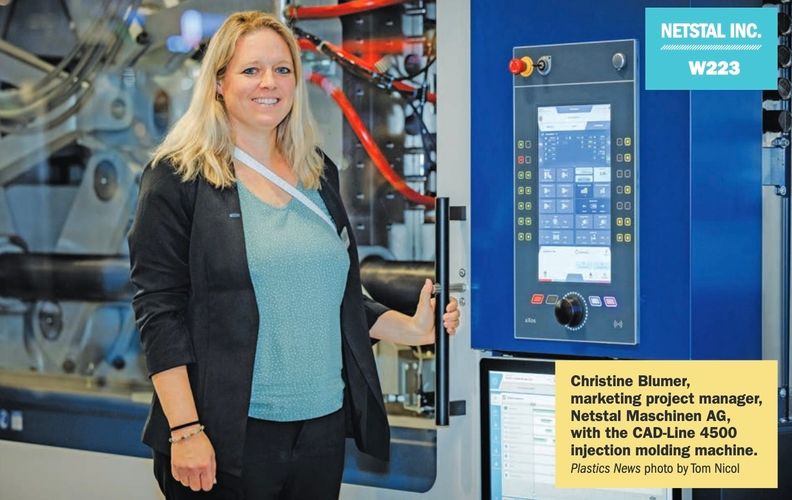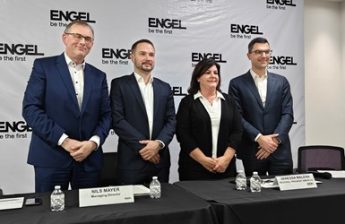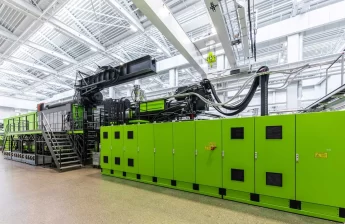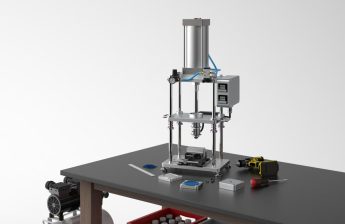At NPE2024, Swiss injection molding machine manufacturer Netstal, best known for building high performance machines with maximum precision and reproducibility, is showcasing two machine exhibits illustrating precisely these strong points.
The first is a clear cup weighing around 15 g and a filling volume of 450 ml, produced from virgin PET from Eastman Chemical Company. The cups are returned to the PET cycle via the NPE recycling program. The labels are also made of PET and are provided by Belgian IML specialist Verstraete. The test mold with two cavities and the IML robot, are supplied by Canadian partner StackTeck.
The cup has been optimized for joint recycling with PET bottles. As Netstal pointed out,
Recycling rates for thin-walled plastic packaging, such as cups, are still low around the world, while across Europe, half of all PET bottles placed on the market were recycled in 2020, a trend that is rising worldwide.
The idea then arose that the two packaging types could be combined, especially in light of the material’s good recyclability and the established recycling systems in many countries. The PET packaging must meet certain criteria to be allowed in the PET collection systems and processed together with PET bottles. Clear packaging is preferred. The recycled material obtained in this way can then be processed into new bottles or packaging.
Netstal’s expertise in PET was also one of the reasons it was recently acquired by Krones, according to Christine Blumer, the Marketing Project Manager at Netstal, as with the acquisition, they also got Netstal’s PET machine and now covers all technologies required from injection molding to PET container production through to filling/packaging and recycling. Under the new ownership, Netstal will continue to operate independently on the market with the aim of achieving growth in all applications but benefitting from the global Krones set-up, said Blumer.
CAP-line: speed and precision
The second exhibit at the booth, a CAP-Line with a clamping force of 4500 kN based on the company’s Elios platform, but has been specifically pre-configured for closure applications.
An optimized barrier screw allows a smaller injection unit to be used, ensuring a higher plasticizing performance and a better degree of homogenization. The CAP-line, customized for closure applications, is one of the ways Netstal is aligning its portfolio more closely with its customers’ applications. And pre-configuration can speed up the consultation and quotation process so that delivery times for the machine are as short as possible, said a company spokesperson.
The system running at the Netstal booth is producing 26 mm tamper-evident caps for still water and is equipped with a 128-cavity mold from z-moulds. z-moulds was able to make the mold as small and light as a 96-cavity mold, allowing a smaller machine to be used. Due to the compact design, less mass must be moved, which has a positive effect on the cycle time: running a mold with 128 cavities at a cycle time of less than 2 seconds is a world first. At around 50 square meters, the complete production system also requires very little floor space. More output per square meter of production area is currently not possible, said Netstal.
In addition, there are further cost savings and a smaller environmental footprint thanks to the low power consumption: with 128 cavities, the CAP-Line 4500 consumes around 12% less electricity than competitor machines operating with only 96 cavities. The system is identical to two cap production lines currently in operation at Alltrista Plastics LLC, a contract manufacturer specializing in high-volume precision manufacturing, who also successfully reduced the weight of the closures by some 25% compared to previous industry benchmark, without compromising performance.
PET showing positive development
Like everyone in the plastics machinery space, Netstal, too has seen some falling away in sales levels. However, said Blumer, in PET we see a ‘very positive development thanks to our new side entry machine’.
“The strongest business application in sales is packaging following by closures and PET. We offer innovative solutions to increase production efficiency in all relevant fields of application. This also includes increased sustainability in the form of energy-efficient technology and reduced material consumption,” she added.
The company is also presenting its new Axos 9 control system at the NPE, she said. Thanks to the integration of Smart Operation, employees in the production environment operate the machines quickly, safely, and effectively – with fewer production rejects.
“We are always aiming to Always maximize our customers’ production efficiency. We all know that our customers are in a very competitive market. Total cost per parts is key. Therefore, a smart integration of take-out robots, including connection of further peripherical equipment is important to increase productivity. Making use of the data of all this equipment and making this relevant to our customer is therefore key.”
Netstal is currently working on the integration of AI into its intelligent solutions but said it will not have anything ready for the market before 2025.
Circularity
Netstal is also working to support customers with their circularity ambitions and to this end is focussing on, among others, PET.
“The PET sector in particular is a prime example of how a recycling loop works. PET bottles are a mono-material. More and more products are being filled into bottles made from up to 100% rPET. With our PET line, we have optimized technology for processing rPET.,” said Blumer.
“However, PET also has potential for thin-wall packaging. As our exhibit here at NPE shows, it can even be collected and recycled together with PET bottles after use. We see plastics as part of the solution if they are used correctly. We therefore also expect politics to recognize the potential and promote the development of national collection systems. Because only whatever is collected can be recycled.”
Source: sustainableplastics.com







